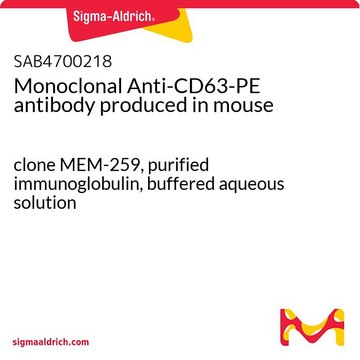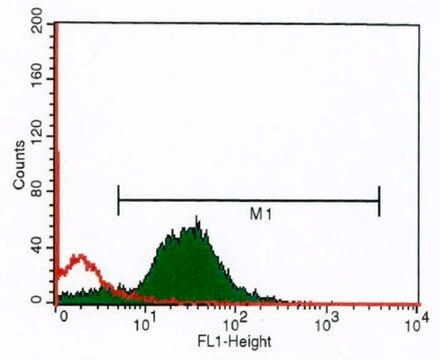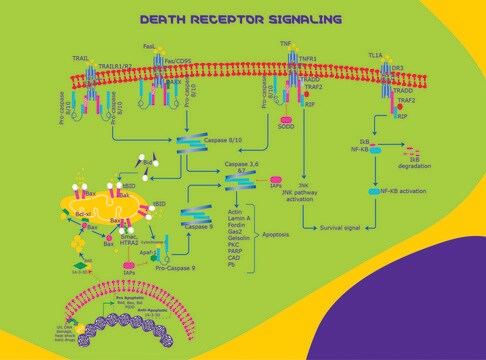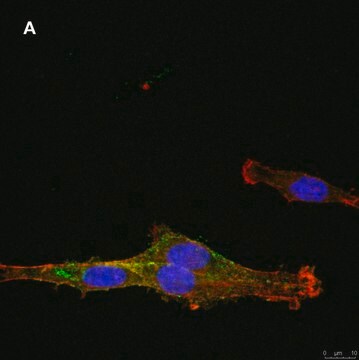SAB4700005
Monoclonal Anti-CD95 antibody produced in mouse
clone LT95, purified immunoglobulin, buffered aqueous solution
Synonym(e):
Anti-FAS
Anmeldenzur Ansicht organisationsspezifischer und vertraglich vereinbarter Preise
Alle Fotos(1)
About This Item
UNSPSC-Code:
12352203
NACRES:
NA.41
Konjugat:
unconjugated
application:
FACS
Klon:
LT95, monoclonal
Speziesreaktivität:
human
citations:
6
Methode(n):
flow cytometry: suitable
Empfohlene Produkte
Biologische Quelle
mouse
Qualitätsniveau
Konjugat
unconjugated
Antikörperform
purified immunoglobulin
Antikörper-Produkttyp
primary antibodies
Klon
LT95, monoclonal
Form
buffered aqueous solution
Speziesreaktivität
human
Konzentration
1 mg/mL
Methode(n)
flow cytometry: suitable
Isotyp
IgG1
NCBI-Hinterlegungsnummer
UniProt-Hinterlegungsnummer
Versandbedingung
wet ice
Lagertemp.
2-8°C
Posttranslationale Modifikation Target
unmodified
Angaben zum Gen
human ... FAS(355)
Verwandte Kategorien
Allgemeine Beschreibung
CD95, also known as Fas (fatty acid synthase) cell surface death receptor/APO-1, is encoded by the gene mapped to human chromosome 10q23.31. The encoded protein belongs to the tumor necrosis factor receptor superfamily and is expressed on a variety of cells including activated T and B cells. CD95 contains a death domain.
The antibody LT95 reacts with CD95 (Fas/APO-1), a 46 kDa single chain type I glycoprotein of the tumour necrosis factor/nerve growth factor (TNF/NGF) receptor superfamily, expressed on a variety of normal and neoplastic cells. It seems that the antibody LT95 does not induce Fas mediated apoptosis, although it cross-blocks anti-Fas DX2 antibody that recognizes a functional epitope of Fas molecule.
Immunogen
HUT-78 human T cell lymphoma cell line
Anwendung
Monoclonal Anti-CD95 antibody produced in mouse has been used as a apoptosis inducer.
Biochem./physiol. Wirkung
CD95/ Fas (fatty acid synthase) cell surface death receptor interacts with its natural ligand (FasL/CD95 L) and plays a vital role in regulation of T-cell homeostasis, by promoting apoptosis via activation-induced cell death (AICD). Mutation in the gene has been associated with the development of Sézary syndrome (SS) and Canale–Smith syndrome. CD95 gene loss can be used as a genetic marker of PSA recurrence after radical prostatectomy.
Leistungsmerkmale und Vorteile
Evaluate our antibodies with complete peace of mind. If the antibody does not perform in your application, we will issue a full credit or replacement antibody. Learn more.
Physikalische Form
Solution in Tris buffered saline, pH 8.0, with 15 mM sodium azide.
Sie haben nicht das passende Produkt gefunden?
Probieren Sie unser Produkt-Auswahlhilfe. aus.
Lagerklassenschlüssel
10 - Combustible liquids
WGK
WGK 1
Flammpunkt (°F)
Not applicable
Flammpunkt (°C)
Not applicable
Hier finden Sie alle aktuellen Versionen:
Besitzen Sie dieses Produkt bereits?
In der Dokumentenbibliothek finden Sie die Dokumentation zu den Produkten, die Sie kürzlich erworben haben.
Downregulation of Fas Gene Expression in Sezary Syndrome Is Associated with Promoter Hypermethylation
Jones CL
The Journal of Investigative Dermatology, 130, 1116-1125 (2010)
Chlorpyrifos and Cypermethrin Induce Apoptosis in Human Neuroblastoma Cell Line SH-SY5Y
Raszewski G
Basic and Clinical Pharmacology and Toxicology, 116, 158-167 (2015)
Cytotoxicity-dependent APO-1 (Fas/CD95)-associated proteins form a death-inducing signaling complex (DISC) with the receptor.
Kischkel FC
The Embo Journal, 14, 5579-5588 (1995)
Exploring prostate cancer genome reveals simultaneous losses of PTEN, FAS and PAPSS2 in patients with PSA recurrence after radical prostatectomy.
Ibeawuchi C
International Journal of Molecular Sciences, 16, 3856-3869 (2015)
Katrin A Salva et al.
Photochemistry and photobiology, 94(5), 1058-1065 (2018-04-21)
Aminolevulinate-based photodynamic therapy (ALA-PDT) selectively eliminates diseased tissues primarily through the induction of intrinsic apoptotic pathway. ALA-PDT is a first-line therapy for actinic keratosis, however, it is less effective for cutaneous T-cell lymphoma (CTCL). We have previously demonstrated that the
Unser Team von Wissenschaftlern verfügt über Erfahrung in allen Forschungsbereichen einschließlich Life Science, Materialwissenschaften, chemischer Synthese, Chromatographie, Analytik und vielen mehr..
Setzen Sie sich mit dem technischen Dienst in Verbindung.






